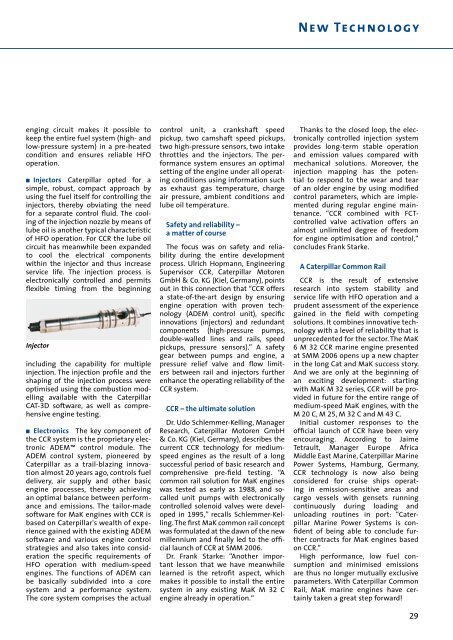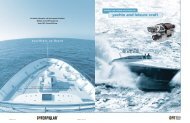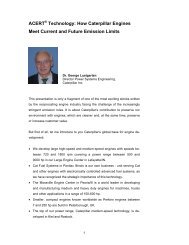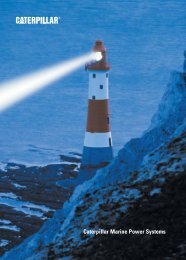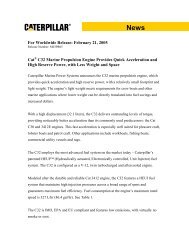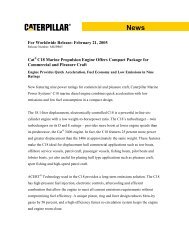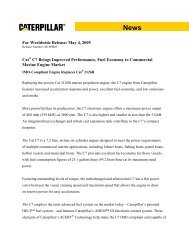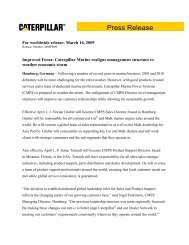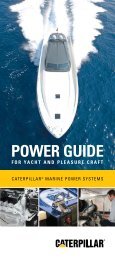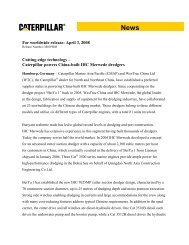Caterpillar Marine - Marine Engines Caterpillar
Caterpillar Marine - Marine Engines Caterpillar
Caterpillar Marine - Marine Engines Caterpillar
You also want an ePaper? Increase the reach of your titles
YUMPU automatically turns print PDFs into web optimized ePapers that Google loves.
enging circuit makes it possible to<br />
keep the entire fuel system (high- and<br />
low-pressure system) in a pre-heated<br />
condition and ensures reliable HFO<br />
operation.<br />
n Injectors <strong>Caterpillar</strong> opted for a<br />
simple, robust, compact approach by<br />
using the fuel itself for controlling the<br />
injectors, thereby obviating the need<br />
for a separate control fluid. The cooling<br />
of the injection nozzle by means of<br />
lube oil is another typical characteristic<br />
of HFO operation. For CCR the lube oil<br />
circuit has meanwhile been expanded<br />
to cool the electrical components<br />
within the injector and thus increase<br />
service life. The injection process is<br />
electronically controlled and permits<br />
flexible timing from the beginning<br />
Injector<br />
including the capability for multiple<br />
injection. The injection profile and the<br />
shaping of the injection process were<br />
optimised using the combustion modelling<br />
available with the <strong>Caterpillar</strong><br />
CAT-3D software, as well as comprehensive<br />
engine testing.<br />
n Electronics The key component of<br />
the CCR system is the proprietary electronic<br />
ADEM control module. The<br />
ADEM control system, pioneered by<br />
<strong>Caterpillar</strong> as a trail-blazing innovation<br />
almost 20 years ago, controls fuel<br />
delivery, air supply and other basic<br />
engine processes, thereby achieving<br />
an optimal balance between performance<br />
and emissions. The tailor-made<br />
software for MaK engines with CCR is<br />
based on <strong>Caterpillar</strong>'s wealth of experience<br />
gained with the existing ADEM<br />
software and various engine control<br />
strategies and also takes into consideration<br />
the specific requirements of<br />
HFO operation with medium-speed<br />
engines. The functions of ADEM can<br />
be basically subdivided into a core<br />
system and a performance system.<br />
The core system comprises the actual<br />
control unit, a crankshaft speed<br />
pickup, two camshaft speed pickups,<br />
two high-pressure sensors, two intake<br />
throttles and the injectors. The performance<br />
system ensures an optimal<br />
setting of the engine under all operating<br />
conditions using information such<br />
as exhaust gas temperature, charge<br />
air pressure, ambient conditions and<br />
lube oil temperature.<br />
Safety and reliability –<br />
a matter of course<br />
The focus was on safety and reliability<br />
during the entire development<br />
process. Ulrich Hopmann, Engineering<br />
Supervisor CCR, <strong>Caterpillar</strong> Motoren<br />
GmbH & Co. KG (Kiel, Germany), points<br />
out in this connection that “CCR offers<br />
a state-of-the-art design by ensuring<br />
engine operation with proven technology<br />
(ADEM control unit), specific<br />
innovations (injectors) and redundant<br />
components (high-pressure pumps,<br />
double-walled lines and rails, speed<br />
pickups, pressure sensors).” A safety<br />
gear between pumps and engine, a<br />
pressure relief valve and flow limiters<br />
between rail and injectors further<br />
enhance the operating reliability of the<br />
CCR system.<br />
CCR – the ultimate solution<br />
Dr. Udo Schlemmer-Kelling, Manager<br />
Research, <strong>Caterpillar</strong> Motoren GmbH<br />
& Co. KG (Kiel, Germany), describes the<br />
current CCR technology for mediumspeed<br />
engines as the result of a long<br />
successful period of basic research and<br />
comprehensive pre-field testing. “A<br />
common rail solution for MaK engines<br />
was tested as early as 1988, and socalled<br />
unit pumps with electronically<br />
controlled solenoid valves were developed<br />
in 1995,” recalls Schlemmer-Kelling.<br />
The first MaK common rail concept<br />
was formulated at the dawn of the new<br />
millennium and finally led to the official<br />
launch of CCR at SMM 2006.<br />
Dr. Frank Starke: “Another important<br />
lesson that we have meanwhile<br />
learned is the retrofit aspect, which<br />
makes it possible to install the entire<br />
system in any existing MaK M 32 C<br />
engine already in operation.“<br />
New Technology<br />
Thanks to the closed loop, the electronically<br />
controlled injection system<br />
provides long-term stable operation<br />
and emission values compared with<br />
mechanical solutions. Moreover, the<br />
injection mapping has the potential<br />
to respond to the wear and tear<br />
of an older engine by using modified<br />
control parameters, which are implemented<br />
during regular engine maintenance.<br />
“CCR combined with FCTcontrolled<br />
valve activation offers an<br />
almost unlimited degree of freedom<br />
for engine optimisation and control,“<br />
concludes Frank Starke.<br />
A <strong>Caterpillar</strong> Common Rail<br />
CCR is the result of extensive<br />
research into system stability and<br />
service life with HFO operation and a<br />
prudent assessment of the experience<br />
gained in the field with competing<br />
solutions. It combines innovative technology<br />
with a level of reliability that is<br />
unprecedented for the sector. The MaK<br />
6 M 32 CCR marine engine presented<br />
at SMM 2006 opens up a new chapter<br />
in the long Cat and MaK success story.<br />
And we are only at the beginning of<br />
an exciting development: starting<br />
with MaK M 32 series, CCR will be provided<br />
in future for the entire range of<br />
medium-speed MaK engines, with the<br />
M 20 C, M 25, M 32 C and M 43 C.<br />
Initial customer responses to the<br />
official launch of CCR have been very<br />
encouraging. According to Jaime<br />
Tetrault, Manager Europe Africa<br />
Middle East <strong>Marine</strong>, <strong>Caterpillar</strong> <strong>Marine</strong><br />
Power Systems, Hamburg, Germany,<br />
CCR technology is now also being<br />
considered for cruise ships operating<br />
in emission-sensitive areas and<br />
cargo vessels with gensets running<br />
continuously during loading and<br />
unloading routines in port: “<strong>Caterpillar</strong><br />
<strong>Marine</strong> Power Systems is confident<br />
of being able to conclude further<br />
contracts for MaK engines based<br />
on CCR.”<br />
High performance, low fuel consumption<br />
and minimised emissions<br />
are thus no longer mutually exclusive<br />
parameters. With <strong>Caterpillar</strong> Common<br />
Rail, MaK marine engines have certainly<br />
taken a great step forward!<br />
29


